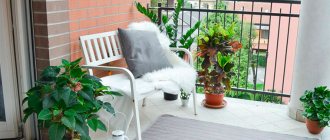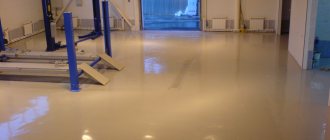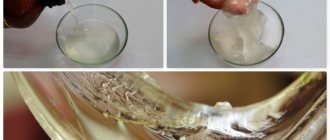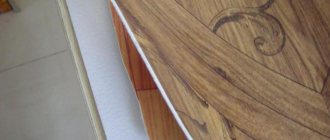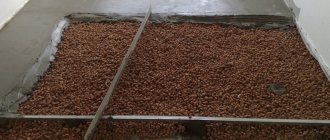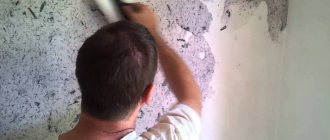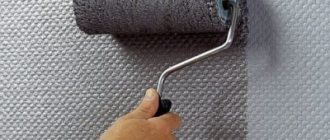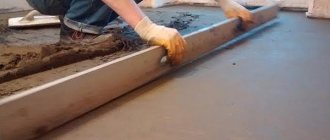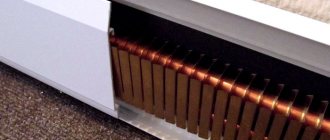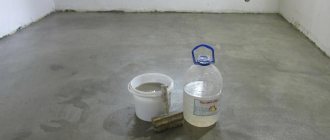To lay any floor covering, you need to prepare the base and make it perfectly level. Leveling the base occurs mainly using a wet cement-sand screed or a dry screed using bulk and sheet materials. But progress does not stand still. Recently, mechanized floor screed has become widespread. With its help, you can level the base efficiently, quickly and with minimal labor costs. Today we will tell you about the advantages of such a screed, introduce it to its technology and the equipment necessary for its implementation.
Purpose and functions of screeds
Screed is a leveling layer of the floor that bears operational loads.
The screed performs a number of functions:
Makes the floor surface smooth.- Allows you to distribute the load of the floor over the entire area.
- Gives structures strength.
- Helps hide communications and the “warm floor” system.
- Prevents heat loss.
Increases the sound insulation of the apartment. It dampens noise and loud sounds.- Creates a surface slope.
- Raises the floor level.
Screed is a technological process that helps to achieve a perfectly flat surface for finishing.
Main types of screeds
There are 4 types of screeds:
- dry;
- semi-dry;
- wet;
- bulk.
Wet screed
There are 4 types of wet screed:
The most popular is knitted. This option involves screeding the slabs.- Installation of screed on the waterproofing layer. It is usually performed in rooms with high humidity or the likelihood of water spills in them (bathroom, toilet, kitchen).
Wet screed using thermal insulation material. It is installed on the ground or on the ground floor of an apartment building. Such a screed is necessary to insulate the house and prevent heat leakage into the basement.- Wet screed ending with a self-leveling coating. This type of screed is used for flooring that is too susceptible to defects: laminate, linoleum, quartz vinyl tiles.
After installing the wet screed, a self-leveling mixture is poured, which can correct all unevenness and defects.
Dry screed
As the name suggests, all components of the screed do not contain liquid..
It consists of two parts:
Backfill part - which not only levels the base, but also creates a heat and sound insulating layer;
Solid sheet covering - this can be plywood, gypsum particle board (GSP), plasterboard sheet (GKL), particle board (chipboard), gypsum fiber board (GVP). They are laid on top of the backfill layer.
Bulk materials for dry screed
Expanded clay or crumbs made from it is foamed clay heated to a high temperature. Expanded clay is weightless due to its low density. It has the best thermal insulation properties.
Foamed vermiculite - this material is very light.
Expanded perlite is made by heating it to high temperatures (1000 degrees). Thanks to the manufacturing process, the water from the volcanic material is completely evaporated. It becomes so light that it can be blown away by the slightest movement of air. Therefore, when installing a dry screed with this bulk material, the windows must be closed.
Self-leveling floors
A type of floor screed that uses self-leveling mixtures is called a self-leveling floor. Its minimum thickness is 3.5 mm. Previously, such coatings were used for industrial buildings, but now they are used in houses and apartments.
The dry mixture is diluted with water according to the instructions to obtain the required consistency. The self-leveling mixture, poured onto the floor, occupies recesses and pits and removes surface defects. When using this mixture, you need to help distribute it over the floor using a spatula, removing air bubbles from it with a needle roller.
Application area
Mechanized screed has found wide application in the construction of multi-storey buildings for residential, commercial and industrial purposes. First of all, this is due to the fact that the preparation of the mortar takes place directly at the construction site and builders do not depend on interruptions in the supply of ready-made mortar from the concrete plant or the breakdown of a vehicle mixer along the way. It is enough to bring to the site the required amount of dry ingredients to prepare the mixture and have a certain amount of water. Also, all work on arranging the subfloor can be carried out even in houses with no power supply due to the fact that the equipment for such work is available with both electric drive and diesel engines (which contributes to an uninterrupted and continuous process of work). Construction time is reduced, since less time is needed for the final drying of a semi-dry screed constructed in this way.
This method is also becoming increasingly popular in individual construction. Some companies specializing in the installation of such screeds are ready to accept orders for work in rooms with a small area (from 40÷50 m²). The treated surface will be ready for laying any finishing floor covering in 8-10 days. Although it must be borne in mind that financial costs will be greater than with traditional methods.
Operated housing
Renovation of secondary housing apartments with a screed device is usually carried out after the purchase of real estate or its significant physical wear and tear. An important feature of performing work in such buildings is the need to remove worn floor coverings and the old leveling layer. This may take additional time and incur additional costs associated with the disposal of construction waste.
New buildings
A significant part of new residential buildings are sold without interior finishing, and apartment owners are forced to independently resolve all issues related to repairs. Mechanized screeding in new buildings will reduce repair time and ensure high quality.
When ordering our services, you should take into account that the larger the area of the apartment or house, the cheaper the finishing will be. Therefore, it will be more profitable for property owners in new buildings to unite with their neighbors and seek the provision of services together with them. The most reasonable prices start with a total area of 80 m2 or more.
Private development objects
The technology of mechanized floor screeding allows for leveling in rooms of complex configuration, which can be seen in individually built houses. Traditional manual pouring of the solution will take quite a lot of time, and in this case, the use of machines and mechanisms will be the best option.
Wooden and frame buildings
The design feature of these houses is the use of lightweight prefabricated floors, which are not designed for a heavy cement layer. In this case, light expanded clay or foam balls are added to the mix as a filler. This material has a lower density and can be laid on a wooden floor.
Garages
The garage floor is subject to significant weight loads from car wheels, and the installation of a leveling layer should eliminate the likelihood of cracks and destruction. A specific feature of garage flooring is the absence of a solid base. Therefore, the solution has to be laid on a sand and gravel bed with the obligatory use of reinforcing mesh.
Advantages and disadvantages of mechanized floor screed
The most popular type of screed is a semi-dry mechanized screed.
Mechanized screed has a number of advantages:
This screed method creates a perfectly flat surface on which any floor covering, even the most capricious, can be laid. Re-leveling is not required, because the floor screed is mechanized using trowelling machines.- For mechanized screed, a solution is prepared to which little water is added. That's why it hardens quickly. After 12 hours it can already withstand the weight of the human body, and after 94 hours construction work can begin.
With this type of screed, fiber fiber is added to make the solution better quality. Fiber fiber helps make the base more durable, prevents microcracks and reduces the final mass of the screed. This option is suitable for houses with weak foundations. Fiber fiber increases the durability of the screed and its abrasion resistance. It is a fibrous structure similar to cotton wool. Fiber fiber is inexpensive. It is necessary to add it to the working mixture.
The availability of mechanized screed lies in the fact that the materials for the concrete mixture are everywhere: sand, cement, fiberglass. Their cost is small.- The mortar for mechanized screed is mixed quickly at the site where construction work is being carried out. The mortar is prepared outside, so there will be no dust and dirt from cement and sand in the room, or splashes from the mortar on the walls.
- High execution speed is an important advantage of mechanized screeding. In 1 day, a team of builders
can apply a screed covering an area of 250 square meters to the floor. With the manual method and wet screed it will take 5-7 days. - Automation of the screed reduces the labor intensity of the work. Kneading, transportation and surface leveling are carried out using machines.
- No leaks to the lower floors. Since little water is added to the solution, the risk of leakage onto neighbors is minimal.
The disadvantages of machine screed include:
Use of expensive equipment. The technology for leveling the base is such that it is impossible to do without special equipment.- If the room is small, then using a mechanized screed is unprofitable. Buying or renting specialized equipment for laying screed and carrying out one-time work in a small area is an expensive pleasure.
- It is unlikely that you will be able to perform the screed using technology yourself, because there is no experience in handling it. Therefore, calling a specialist is necessary.
- Not all construction organizations accept orders for mechanized screeding. They do not service apartments smaller than 100 square meters. Therefore, you need to negotiate with your neighbors about carrying out joint work, and this is very difficult.
- The cost of mechanized screeding is high because special equipment is required.
Popular questions
Under what conditions is the screed laid?
Mechanized semi-dry screeding is performed at positive air temperatures (from +5°C). When using the technology in winter, it is recommended to install heaters or add antifreeze additives to the solution.
After how many days can you walk on the screed?
After 12 hours, you are allowed to move on the floor on foot. You should not start wheelbarrows or other heavy equipment on wheels; you can damage the concrete surface.
When using a semi-dry screed, is it necessary to grout?
The mixture with a small amount of water has a loose structure; after drying, irregularities remain on the surface. To create a perfectly smooth base for finishing, it is recommended to use a trowel.
What is the approximate cost of 1 m2 of semi-dry screed?
The cost of work with turnkey materials starts from 450 rubles per 1 m2.
Is it possible to make a mechanized screed with your own hands?
There are masters who can handle any task, but this technology is considered to be of medium complexity and requires special equipment. A significant role is played by professionalism and skills that the average person may not have. To avoid wasting money and time, it is recommended to seek help from a specialized company that provides this type of service.
Use and equipment for mechanized screeding
Mechanized screed is used when the base surface will become a finishing coating - in garages or warehouses.- This type of screed is also used when the floor covering: linoleum, laminate requires a perfectly flat surface so that there are no flaws. This is much easier to do mechanically. Labor-intensive processes: mixing the solution,
It is transported to the floors and polished by machines. - A machine screed is also needed when you need to make the floor rigid, durable, and install an additional layer of sound insulation.
- A mechanized semi-dry screed is created when it is necessary to hide a water-heated floor system or electric floors.
The following equipment is used for machine screeding:
Pneumatic compressor. This is a multifunctional machine that acts as a pump and mixer. She quickly and thoroughly mixes the working mixture. The pneumatic compressor transports the composition through hoses using high pressure, which facilitates the work of builders. They don't have to carry heavy bags of mixture up to the floors. The design of pneumatic blowers includes a tank for mixing the solution, a supply system, a drive and a concrete pipeline. Pneumatic compressors of the German brands “Putzmeister” and “Brinkmann” are mobile. They move around the construction site on their own chassis. The solution tank holds 640 liters of mixture. The equipment is productive. It quickly supplies the solution to the house: 5 cubic meters per hour.
Quencher. This machine allows you to minimize high pressure, and the solution comes out of it in an even layer, without shock. The device provides high stability when supplying the solution to the house.
A laser level will help you establish its level and place the beacons correctly. The Bosch GRL 250 HV device will allow you to check whether the screed is correctly aligned. Rotary laser levels have a small error. Lasers are famous from
Troweling machine – grinds the screed in such a way that it removes all its unevenness and small voids. It also compacts the surface.
Trowel - helps to level the surface in hard-to-reach places that a trowel could not cope with. The length of the instrument is half a meter. It has a comfortable handle.
Metal ridge - used for cutting expansion joints. The tool is made of aluminum, 280mm long, 120mm wide. Wooden handle. A tool like this helps prevent damage to the subfloor if the materials expand.
Rules – the “Sola” rule is especially appreciated. It helps to level the cement-sand mixture between the beacons. The absence of burrs on it makes it safe and saves you from injury. The presence of shock-absorbing caps protects the surface from scratches and abrasions. The luminous background makes it possible to see the indicators of the tool, which will help level the floor without errors.
What is good about the method according to users?
Among user reviews, the following advantages can be highlighted:
good quality of the floor - it is smooth and strong;- suitable for any floor covering;
- you should not be afraid of flooding your neighbors;
- speed of work.
Consumers highlight the following disadvantages:
- lack of quality with low qualifications of builders;
- the method steals the volume of the room;
- high cost of materials, work and equipment rental.
All users noted the quality of semi-dry screed compared to other types of cement work. And all the disadvantages are associated only with the lack of professionalism and irresponsibility of the builders.
You can read more about user opinions here and here.
Mechanical screed technology
The execution of the screed goes through several stages.
Preparing the base
The base is swept and debris removed. If there are cracks, then putty. The base is treated with a primer.
For sound insulation and waterproofing, a 100-micron thick polyethylene film or a 5-10 mm thick polyethylene foam backing is laid. A damper tape is glued along the perimeter of the walls 3-5 cm above the level of the future screed to compensate for internal stress. After the screed has hardened, the excess damper tape is cut off.
Setting the screed level.
Using a laser level, mark the highest point of the floor and draw a horizontal line.
This is the zero floor level. The thickness of the future screed is set off from it and its level is noted. The thickness of the future screed is calculated.
Preparing the mixture
The working mixture is prepared in a pneumatic supercharger. First, sand is poured, then fiberglass and cement are placed. Lastly, water with a plasticizer introduced into it is poured.
The solution is stirred in the air blower for 3 minutes. The work is carried out outdoors at a temperature not lower than -5 degrees. If it’s cold outside, then a “warmhouse” is built above the place where the solution is mixed.
Receiving the mixture
The mixture is transported to any floor using a pneumatic blower. Compressed air drives the solution through the sleeves - transport hoses. The solution is received in a special absorber connected to a transport hose. It relieves high blood pressure. The mixture is supplied horizontally to a distance of up to 200 meters, and vertically to 80 meters.
Distributing a mixture using a rule
The room temperature should be no lower than +5 degrees. As soon as we have unloaded the semi-dry mixture onto the base, beacons are marked using a laser. Two beacons are installed on opposite walls. If the room is large, then several more beacons are planned between them. The distance between the beacons should be 20cm less than the length of the rule. The working mixture is poured into the space between the beacons, which is then leveled using the rule. The length is usually one and a half to three meters. The rule levels the working surface.
Grouting the screed with a disc grinder
To ensure the surface is perfectly smooth, turn on the grinder and rub the screed with a disc. She also polishes the surface, removing pits and bumps. Machine smoothing and sanding should begin within two hours after mixing the working mixture to prevent it from sticking. When working with a disc grinder, builders wear concrete shoes, because without them, after grinding the screed, you cannot walk on it.
Installation of expansion joints
Carried out in accordance with project documentation. If they are not noted in the design documentation, then expansion joints are cut at doorways, at junctions with protrusions, niches, columns, and in areas with height differences. If the room is large, then the floor area is divided into expansion joints (squares or rectangles) every 15-20 square meters. Expansion joints are necessary to prevent the formation of microcracks during the drying process of the screed.
Caring for hardening screed
After installing the screed, it should be covered with plastic wrap for one or two days so that it hardens evenly, especially if there are drafts, dry air or penetrating bright sunlight in the room.
If the temperature in the apartment is high, then before covering it with film you need to moisten the surface of the screed. After two days, the film must be removed.
And after a few more days you can lay the flooring. But if you are in no hurry, then it is better to wait 28 days, because this is the optimal period for its ripening.
Price of mechanized semi-dry floor screed
Let's compare the prices of semi-dry screed in different cities of our country:
The price of mechanized floor screed in Moscow and St. Petersburg is from 450 rubles per square meter, and machine plastering of walls is 540 rubles per m2,- In Mytishchi - 423 rubles per m2.
- In Saratov, the price for work ranges from 400 to 600 rubles per square meter.
- In Samara, for work on mechanized screed using German technology, you will pay 360 rubles per square meter.
- The price per square meter in Dmitrov varies from 470 rubles to 900, depending on the thickness of the screed and the area.
Prices are given for a turnkey screed, labor and materials are included in the price.
A mechanized screed makes it possible to quickly and without much labor make the floor even and smooth. Any floor covering will look chic and beautiful on such a screed.
Recommendations
We can recommend following the following basic rules for installing screeds using the mechanized method:
- to reduce the risk of cracks, use polypropylene fiber in semi-dry mixtures;
- wet the screed after installation for about 3-5 days;
The screed should be wetted for 3-5 days after installation.
- Make sure that there are as few drafts and high temperatures in the room as possible - this way the moisture will evaporate much faster and cracks may form;
- at sub-zero temperatures in winter, do not allow the top layer of the screed to freeze;
- Sand only after the pressure mark is no deeper than 1 mm.
Following these simple recommendations will help you achieve better results.
It is better if there are no drafts in the room where the semi-dry floor screed was carried out
